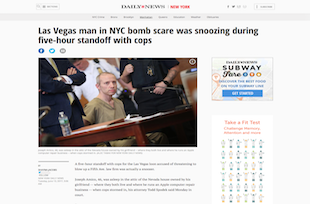Unlawful Imprisonment – 18 U.S.C. § 1201 Sentencing Guidelines
Unlawful Imprisonment – 18 U.S.C. § 1201 Sentencing Guidelines
Thanks for visiting Spodek Law Group, a second-generation firm managed by Todd Spodek with over 40 years of combined experience. When federal prosecutors charge unlawful imprisonment under 18 U.S.C. § 1201, they’re alleging you unlawfully restrained someone’s freedom of movement—confining, detaining, or restricting their liberty—without the aggravating factors that would elevate the offense to kidnapping. While § 1201 is primarily known as the federal kidnapping statute, courts recognize lesser-included unlawful imprisonment offenses for restraints that don’t involve transportation, ransom demands, or extended detention. Sentences vary dramatically: brief unlawful imprisonment might yield months, while imprisonment accompanied by violence or extended duration approaches kidnapping’s life-imprisonment range.
Unlawful Imprisonment vs. Kidnapping
The distinction matters enormously for sentencing:
**Kidnapping** under § 1201 involves seizing, confining, abducting, or carrying away a person across state lines, for ransom, or in violation of federal law, with substantial restraint of liberty. Kidnapping typically involves transportation, extended confinement, or specific intents (ransom, facilitating other crimes). Sentences range up to life imprisonment.
**Unlawful imprisonment** is restraint of liberty without those aggravating factors. Locking someone in a room for hours, restraining them during arguments without moving them significant distances, confining them without ransom demands or intent to commit additional crimes—these constitute unlawful imprisonment. While serious, they lack kidnapping’s heightened culpability elements.
Courts evaluate several factors distinguishing the two:
- **Duration of confinement** – Brief restraints (minutes to hours) suggest imprisonment rather than kidnapping. Extended confinement (days to weeks) indicates kidnapping.
- **Distance moved** – Substantial transportation (across state lines, to remote locations) supports kidnapping. Minimal movement (within the same building, short distances) suggests imprisonment.
- **Purpose of restraint** – Ransom demands, facilitating other crimes, or terrorizing victims indicate kidnapping. Restraints arising from domestic disputes, preventing victims from leaving during arguments, or impulsive confinement suggest imprisonment.
- **Increased danger** – If restraint placed victims in substantially greater danger than they faced before confinement, kidnapping applies. If danger level remained constant, imprisonment is more appropriate.
- **Planning and premeditation** – Kidnapping often involves planning, preparation, and deliberation. Unlawful imprisonment frequently arises spontaneously from volatile confrontations.
The “Asportation” Requirement
Many courts require kidnapping involve some “asportation”—carrying away or transporting victims. When defendants confine victims without moving them, courts often characterize the offense as unlawful imprisonment rather than kidnapping. This doctrine prevents overcharging: locking someone in a closet during a robbery shouldn’t convert robbery into kidnapping unless the confinement substantially exceeded what was necessary for the robbery.
Defense challenges kidnapping charges by demonstrating minimal asportation. If victims were moved only within the same location, if movement was incidental to other crimes, or if defendants confined victims without transporting them, unlawful imprisonment might be the appropriate charge—dramatically reducing sentencing exposure.
Common Unlawful Imprisonment Scenarios
These fact patterns typically result in unlawful imprisonment charges rather than full kidnapping:
- **Domestic violence confinement** – One partner prevents the other from leaving during arguments by blocking doors, taking car keys, physically restraining them. The confinement is temporary and arises from volatile domestic situations rather than planned kidnapping.
- **Workplace restraint** – Employers or coworkers prevent employees from leaving during disputes, lock them in offices during confrontations, or physically block exits. These workplace conflicts involve restraint without kidnapping’s transportation or ransom elements.
- **Robbery-related brief confinement** – Robbers lock victims in back rooms, closets, or bathrooms during robberies. The confinement facilitates theft and prevents immediate pursuit but doesn’t constitute independent kidnapping absent substantial movement or extended duration.
- **False imprisonment during assaults** – Defendants restrain victims during assaults by holding them down, preventing escape, or confining them in rooms. If the restraint is brief and merely facilitates assault rather than constituting separate kidnapping, unlawful imprisonment applies.
Federal Sentencing: Offense Levels 14-28
Federal sentencing guidelines don’t have a separate “unlawful imprisonment” provision. Courts apply guidelines based on the specific circumstances:
When unlawful imprisonment is charged as a lesser-included kidnapping offense, courts might apply §2A4.1 (kidnapping) with significant downward adjustments. Base offense level 32 drops to level 18-24 when victims were voluntarily released without serious harm and confinement was brief.
Alternatively, courts might apply assault or obstruction guidelines when imprisonment occurred in the context of other crimes:
- **If imprisonment involved physical force or threats** – Apply §2A2.2 (aggravated assault), base level 14, with enhancements for injury or weapons
- **If imprisonment obstructed justice** – Apply §2J1.2 (obstruction of justice), base level 14-20 depending on conduct
- **If imprisonment facilitated another offense** – Apply guidelines for the underlying offense with potential enhancements for restraint
At offense level 18 (Category I), sentences range 27-33 months. With acceptance of responsibility (−3 levels to 15), sentences drop to 18-24 months. Most unlawful imprisonment cases involving first-time offenders with brief confinements and no serious injury result in 18-30 month sentences.
When Courts Reject Lesser-Included Instructions
Defendants facing kidnapping charges often request jury instructions on unlawful imprisonment as a lesser-included offense. Courts grant these instructions when evidence could support conviction for imprisonment but not kidnapping—when asportation is minimal, duration brief, or aggravating factors absent.
But courts deny lesser-included instructions when evidence shows clear kidnapping: extended confinement, substantial transportation, ransom demands, or victims held for days. In those cases, juries must choose between kidnapping conviction or acquittal, with no middle-ground unlawful imprisonment option.
Defense strategy when seeking lesser-included instructions: emphasize brevity of confinement, minimal movement, lack of planning, and spontaneous nature of restraint. Present evidence that defendants released victims voluntarily, that no ransom was demanded, that defendants acted impulsively during domestic disputes or arguments rather than executing planned abductions.
Defending Unlawful Imprisonment Charges
Challenge whether restraint actually occurred. In domestic violence contexts, alleged victims sometimes exaggerate events—claiming they were “locked in” when they could have left, asserting they were “held captive” when they chose to remain during arguments. Witnesses who observed victims moving freely, evidence that doors were unlocked, communications showing victims could have left but chose to stay—all undermine imprisonment allegations.
Contest the “unlawful” element. Did defendants have authority to restrain? Security personnel detaining shoplifters, teachers restraining violent students, healthcare workers preventing psychiatric patients from leaving under emergency commitment authority—these restraints are lawful when exercised properly. Present evidence of institutional policies, professional obligations, or legal authority supporting defendants’ actions.
Demonstrate lack of intent. Unlawful imprisonment requires intentional restraint. If doors were locked accidentally, if defendants didn’t realize victims wanted to leave, or if misunderstandings led victims to believe they couldn’t leave when they actually could, the intent element isn’t satisfied.
Present mitigation showing brief duration and lack of harm. When imprisonment lasted minutes rather than hours, when victims suffered no injury, when defendants released victims immediately upon realizing their distress, these factors support probationary sentences or minimal incarceration.
Collateral Consequences
Unlawful imprisonment convictions carry serious collateral consequences:
- *Domestic violence implications* – Convictions arising from domestic contexts trigger firearms prohibitions under 18 U.S.C. § 922(g)(9), preventing defendants from possessing guns. For law enforcement, military, and security professionals, this ends careers.
- *Immigration consequences* – Non-citizens face deportation for crimes of violence or crimes involving moral turpitude. Unlawful imprisonment often qualifies, triggering removal proceedings.
- *Professional licensing* – Teachers, healthcare workers, lawyers, and other licensed professionals face disciplinary proceedings. Even brief restraints can result in license revocations.
- *Custody implications* – Parents convicted of unlawful imprisonment—especially in domestic violence contexts—face custody loss or restricted visitation in family court proceedings.
When Imprisonment Accompanies Other Crimes
Unlawful imprisonment frequently occurs alongside other offenses:
**Sexual assault with restraint.** Defendants who confine victims during sexual assaults face both sexual abuse charges and potentially unlawful imprisonment or kidnapping charges. Whether restraint constitutes separate kidnapping depends on whether confinement substantially exceeded what was necessary for the sexual assault.
**Robbery with confinement.** Locking victims in rooms during robberies creates questions about whether imprisonment is a separate offense or merely part of robbery. Federal courts often merge these offenses when confinement was brief and incidental to theft.
**Assault during domestic violence.** Preventing intimate partners from leaving during assaults adds imprisonment to assault charges. Prosecutors charge both, though courts sometimes merge them at sentencing when imprisonment was integral to assault rather than independent offense.
Defense argues against separate punishment for restraints that were merely incidental to other crimes. When imprisonment had no independent purpose beyond facilitating another offense, when duration was minimal, and when danger wasn’t increased by confinement, courts should merge offenses rather than stack sentences.
Todd Spodek built this firm defending clients where volatile confrontations—domestic disputes, workplace arguments, impulsive decisions during crimes—resulted in kidnapping charges that didn’t reflect the conduct’s actual severity. Brief restraints lasting minutes were charged as kidnapping carrying life imprisonment exposure. Domestic violence situations where neither party could leave without escalating confrontation were characterized as one partner unlawfully imprisoning the other. Our representation taught us that unlawful imprisonment charges often involve conduct far more ambiguous than charging documents suggest, situations where both parties contributed to confrontations, and restraints that arose spontaneously rather than through calculated kidnapping plans. Defending these cases requires presenting context that charging documents omit, demonstrating that defendants acted impulsively during volatile situations rather than executing planned confinements, and arguing that brief restraints don’t warrant decades of imprisonment. If you’re charged with unlawful imprisonment or kidnapping, contact us immediately. These charges carry enormous sentencing exposure, and early investigation—securing witness statements, obtaining surveillance footage, documenting relationships and contexts—determines whether prosecutors can sustain kidnapping charges or must reduce to imprisonment or dismiss entirely. We’re available 24/7.














NJ CRIMINAL DEFENSE ATTORNEYS